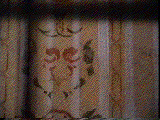The imagery of the wallpaper in the film was overdone, I think. The story
described the wallpaper in great detail, so I was excited to finally get to see
it when we watched the film. It turns out, however, that the wallpaper as a
symbol impacted me with much more force in the short story. Perhaps the added
imaginative effort, or at least the process of visualization that is inspired by
reading
The film, paradoxically, by showing more, gives too much away. In one way we can
say that the film is offering a reading of the story through the image of the
wallpaper.


The first still suggests the idea of imprisonment, by placing
a series of vertical bars throughout the wallpaper. In addition, imprisonment is
suggested by the face appearing to be in the background of the wallpaper. In the
close up, this face shows some of the bulbousness described in the text.
In the text, however, the lolling broken neck, and the two
bulbous eyes present more than just a face. They image death. They also pour from
the narrator as imaginative description. One might interpret that the narrator's
outpouring parallels the author's description. Or the figures may point toward a
more psychological interpretation. On one level, the film's vision of the
wallpaper restricts these possibilities.
Return to the film wallpaper site, to the Yellow Wallpaper site, or to the American Literature Survey Site.

